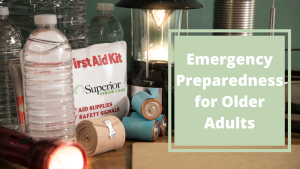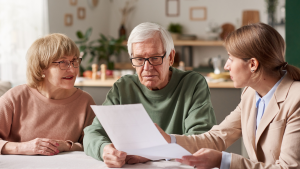
Natural disasters like hurricanes, tornados, fires, and floods can happen at any time. They sometimes come without warning and can directly affect daily life. Though it’s difficult to imagine a disaster striking your area, it’s important to be prepared especially if you or your loved one is an older adult. Older adults often have health issues and conditions that require support, medication, and/or medical attention that could be disrupted if a natural disaster strikes without a plan in place.
 Creating a Plan
Creating a Plan
The first step to preparing for an emergency is to create a plan. Communicate with you friends, family, and neighbors that you are creating a plan that will involve them.
- Identify the natural disasters in your area to know what to prepare for. Find the disasters that could happen in your area with this map of Common Disasters Across the U.S. from The Red Cross.
- Choose a contact person who will check in on you and agree on a communication method for how they will reach you. If you have a good relationship with your neighbors, you can develop a plan for everyone to check in on each other. Make sure that your contact person has a copy of your key to your house.
- Create a list of friends and family members’ phone numbers and leave a copy next to your phone.
- Be ready to make a decision to stay or go. Depending on what the situation is, you may need to leave your home for an extended period of time or you may need to shelter in place for a couple of weeks. So it’s important to prepare for either situation and prepare to make a decision that might ultimately save your life.
- Create an evacuation plan. If you live in an assisted living or retirement community learn about the emergency procedures that are in place, Make sure you know the important exit routes and meeting places, keep a copy in your emergency supply kit. Identify two different ways to exit each room in case of a fire. If you need assistance to evacuate, find local registries that can help you. Some examples are; SMART911, Code Red, or a local county registry, they can help first responders to rapidly assist those in need.
 Assess Your Needs
Assess Your Needs
Once you have a basic plan together, you’ll need to assess your personal needs to help create a kit that will help during an emergency.
- What are your medical, physical and cognitive needs? Do you need specific medication or equipment? Is there anything that might affect your ability to respond to an emergency?
- Do you have equipment that needs to be powered by electricity or do you have medication that needs to be kept cold? It’s important to evaluate your power needs and make a backup plan for what you will do if you are out of power for an extended amount of time.
- During some natural disasters the mail might not run as usual, if you receive Social Security or other federal benefits it is beneficial to switch to online or electronic payments, to prevent a disruption in your payments and can also prevent lost or stolen checks.You can sign up for direct deposits of federal benefits by calling 800-333-1795 or sign up online.
- Evaluate your property or renter’s insurance to make sure that your policy will cover any damage that might incur.
 Creating an Emergency Supply Kit
Creating an Emergency Supply Kit
After you have a plan in place and you have assessed all of your personal needs, it’s time to create an Emergency Supply Kit that will have all of the important items and information you will need to make an emergency as manageable as possible.
- The Red Cross has an extensive Survival Kit checklist that’s a good resource of items to keep in your car, home, or ready for an evacuation.
- Make sure you have at least a 30 day supply of medication and any assistive items you may need such as a cane or eyeglasses.
- Plan for food needs, especially if you have special dietary needs. Keep nonperishable food items with you emergency supply kit.
- Stock up on batteries.
- Copies of your emergency contacts, exit routes and meeting places.
- Important documents. Collect all your important identification, medical, financial, and legal documents. Keep the originals in a waterproof bag and make copies to put in your emergency supply kit.
- Create an up-to-date medical information list. This CDC Complete Care Plan PDF can help others understand your medical needs.
All emergencies and natural disasters are full of unknown circumstances. While you can’t control what happens around you, being prepared can make things go much more smoothly with less stress. Following these suggestions can help you to be prepared for anything and keep you safe.
Resources:
https://www.cdc.gov/aging/publications/features/older-adult-emergency.html
https://www.redcross.org/get-help/how-to-prepare-for-emergencies/older-adults.html
https://www.ready.gov/disability

Add Comment